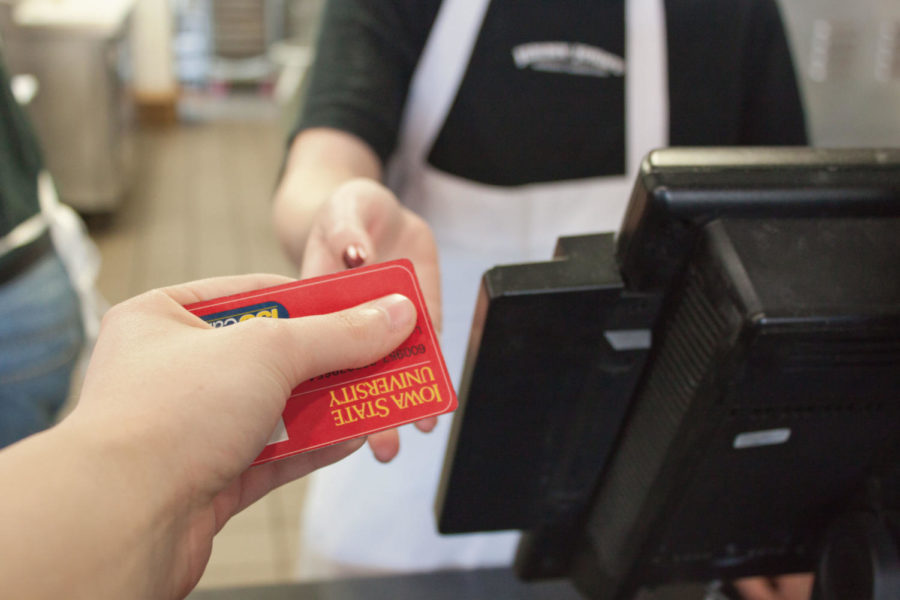Should Dining Dollar$ be usable in Campustown?
October 1, 2012
An issue that has been explored by the Government of the Student Body for quite some time — the availability of usage of Dining Dollar$ in Campustown — is one that could possibly become a reality within the next year.
The proposal of using Dining Dollar$ in Campustown has been a goal of GSB for many years. Last spring, GSB elected its new president, Jared Knight, and he has taken up this cause.
Spencer Hughes, GSB director of student affairs and a cabinet member of Knight, approached him with the issue of the Dining Dollar$ proposal, and Knight showed a great interest.
Originally approaching officials with the university, the idea was to work with CyCash off campus. Multiple concerns with CyCash were confronted with the proposal, and GSB shelved the idea.
After regrouping, it was decided a new angle and more research was necessary. The angle has now been shifted to Dining Dollar$.
When asked why Dining Dollar$ were more viable than CyCash, Knight said: “Dining Dollar$ gives us more flexibility and utility.”
Dining Dollar$ were decided as the better alternative because it allowed more freedom and options. CyCash, in essence, was designed only for small purchases on campus and had a cap of $50, forcing the issue of often refilling the account. Dining Dollar$, which do not have the limits applied to the CyCash system, was a better option for students, Knight said.
Currently, Dining Dollar$ can be used at vending machines, campus cafes, the Hub, convenience stores, residential dining centers, and campus restaurants such as Clyde’s Sports Club, Hawthorn and the Memorial Union Food Court.
Developing something before approaching the university was something GSB had overlooked, and many in the past had done the same.
Hughes said: “We want to have that kind of support from the back and then be able to come with the program that works with students and the university and the businesses at the same time.”
Freshmen and sophomores, who make up the majority of students living in resident halls, most commonly use the Dining Dollar$ attached to their meal plans, which are in turn a required purchase with a student’s room and board.
After speaking with students, Hughes said he learned dining centers are being stretched to their limit with limited seating. As such, Dining Dollar$ are not being utilized to their full potential, he said.
Once Dining Dollar$ have been purchased, they become the responsibility of the students, and are nonrefundable. If any unused Dining Dollar$ remain at the end of the academic year, they will expire and are not recoverable. Dining Dollar$ for the 2012–13 school year expire May 11, 2013.
Hughes said he believes the option of Campustown restaurants and businesses will provide more freedom to students to use their total amount of Dining Dollar$ and help to foster early connections with new students and the Campustown community.
Businesses such as Stomping Grounds and Lorry’s Coffee can also become a study place for students with food instead of just dens in the dorms.
Gabby Williams, president of the Campustown Student Association, immediately talked with local businesses and the Campustown Action Association.
“They will support us, but they want it only if students want it,” Williams said. “It’s really a student initiative.”
When asked if GSB believed if Campustown business would take away from dining center business, Hughes and Williams agreed in saying the convenience of dining centers can’t be overlooked. Campustown will take some of the burden from the dining centers.
David Swenson, associate scientist of economics, explains the effects this change will have on the area economically:
“The use of Dining Dollar$ would shift student spending from ISU-supported venues … to off-campus venues. That shift in spending will, of course, have mostly a zero-sum economic outcome: The private sector gains, while the campus sectors lose. The net effect is zero economic growth. The up side to this, of course, is that students will have more dining choices, though convenience necessarily suffers when one factors in travel times.”
He continues by bringing up some of the negative effects this shift will have on the community: “The down side of this is that ISU food-producing institutions depend on a captured demand, and they are configured and distributed relative to that demand. If dollars are diverted off campus, then the overall dining offerings — if not venues — on campus will likely constrict. In addition, the more dining done outside of residence hall dining facilities, the less efficient those systems, which in turn puts upward pressure on meal costs.”
As for the restaurants, certain restrictions would have to be in place. For example, accepting Dining Dollar$ for alcohol can cause the restaurant to be penalized and taken off of the program.
Knight has had conversations with ISU President Steven Leath, who Knight said is open to exploring the idea. Knight has also spoken with Tom Hill, vice president of student affairs, and Nancy Levandowski, director of ISU Dining. They are both receptive to the idea as well.
Swenson also gave his professional opinion on the shift to using Dining Dollar$ in Campustown: “This seems quite a stretch from my perspective. Rules established for maximizing the use of student resources on campus make no sense once the boundary between the institution and the rest of the private sector is crossed. The use of those dollars at ISU-approved food vendors can be argued to make great sense regarding students’ needs and convenience while in attendance at classes, etc., and other student activities. The extension of that allowance to entities off campus can only be primarily justified as a mechanism for boosting private sectors sales.”
GSB is still in the research stage and getting rid of bugs in their proposal. Their goal is to have this pushed through and accomplished within a year.







